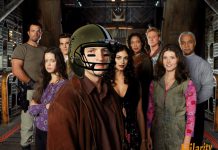Thunderball saw the 007 craze of the 1960’s hit its peak making more than $1 billion when adjusted for inflation – a number not surpassed until 2012’s Skyfall. Whereas Skyfall has become acclaimed as one of the best in the series, Thunderball has remained overshadowed by its stylistic predecessor Goldfinger, a result that is probably for the best.
Throwing in everything imaginable (and unimaginable!) from jetpacks to shark-filled pools to underwater military battles, this was the first film in the series released with the confidence of Bond at the top of his game and the first to cement the trope of Bond saving the world from a truly global threat – and all thanks to the most ridiculous of coincidences…
Thunderball (1965) |
Growing up, I was a fan of the original MacGyver TV series starring Richard Dean Anderson. Featuring a super-spy turned government think tank troubleshooter turned environmentalist turned urban social worker (the series had some, um, “range” – yes, that’s it), each episode of MacGyver began, for the most part, with the titular character setting off on government missions or receiving his orders; yet, as the series progressed, MacGyver would often find himself randomly entering a city or town before being unwittingly thrust in the middle of a terrible conspiracy such as fake alien encounters, illegal chemical labor wars, or the Native American’s plight against the devastating threat of electricity. It seemed like wherever this mulleted genius wandered, trouble would follow – trouble that he was specifically skilled to deal with and coincidences that kept getting harder and harder to accept.
What does that have to do with James Bond and Thunderball, you ask? Fair question. The answer: the entire plot of of the film hinges on a chance encounter Bond (Sean Connery) has at a health clinic while he is off hours and flirting with a nurse. That would be acceptable enough on its own, except that it just so happens that after Bond leaves said clinic, he is coincidentally assigned with a case specifically tied to that encounter, giving the character sudden insight that could avert global threat! The entire world’s existence owes its thanks to Bond getting randy with a hot nurse and suddenly noticing foul play at work!

With that fortuitous piece of kismet destiny in mind, Bond receives his mission: track down two stolen NATO nuclear warheads being used by the evil organization S.P.E.C.T.R.E. to blackmail the world for £100 million in diamonds. Based on his chance encounter (sigh) with a dead air force pilot at the Shrublands health clinic, Bond travels to Nassau in hopes that the pilot’s sister, Domino (Claudine Auger), may yield new information. By yet another sheer coincidence, Domino happens to be the mistress of the villainous mastermind – eye-patched S.P.E.C.T.R.E. agent Emilio Largo (Adolfo Celi).
Now there are those who may argue that the plot of a James Bond film should never be scrutinized. They would debate that the “plots” are nothing more than thin strings for over-the-top action set pieces, beautiful girls, wanton property destruction, and other such fantasies. Admittedly, there are times when this can be true, but to whitewash the entire franchise as a whole with this abstraction is unwarranted. There are genuinely good-to-great films in the series with many gaining critical acclaim and acceptation as movie classics (e.g. From Russia with Love, Goldfinger, Casino Royale ’06, and even On Her Majesty’s Secret Service). I would agree that there are hardly any films in existence that don’t contain any plot holes or coincidences (life as we know it hinges on them). The trick is to present the story well with gripping narratives and characters to the point that the audience is engaged enough to allow a suspension of disbelief. When you have coincidences piled on top of other coincidences piled on top of others, you betray the audience’s trust and intelligence thus losing that suspension.
Thunderball is far, far away from being the most egregious example of this fallacy but it is hard to overlook – especially when you have overlong underwater sequences that bog down the whole film. Nary is there a tropical fish or creature in the whole of the Caribbean that doesn’t make an appearance in this film! The most flagrant instance is a scene that depicts every single phase of a fighter jet theft and its submerged resting place in great detail for over twelve minutes! The hypnotic music by the great John Barry unfortunately does not help the pacing here. My office aquarium has more energy than some of these sequences and I can hardly remember if there are any fish left in it!

The shame of it is that Thunderball‘s overall plot is a good one. S.P.E.C.T.R.E.’s blackmail of the world’s governments is a strong hook on its own. It didn’t need an elaborate sequence of serendipitous events to hang it on. The climactic underwater battle is incredibly impressive (and surprisingly bloody), winning an Academy Award for Visual Effects, but it too, like a majority of the film’s underwater sequences, is protracted to the point of monotony. When Sean Connery finally makes his entrance in the climactic battle, it isn’t helped that he’s piloting an underwater propulsion unit apparently powered by the caffeine-energy of Mountain Dew!

This is where Thunderball and many of the subsequent films started to trade realism for fantasy. Where Goldfinger provided a good balance of gadgetry and imagination where the ultimate victory lay on Bond’s quick-thinking and actions (such as his electrocution of over-powering adversaries), Thunderball is the where the gadgetry started becoming deus ex machinas for any given situation. James Bond could no longer have a grand rooftop chase or a regular scuba tank. No, now he had jetpacks and…underwater jetpacks!
Nevertheless, the film has many moments of wit and imagination. Bond’s constant teardowns of Largo, especially during a skeet shooting match, are classic with the film containing some of the most memorable puns in the series. Thunderball‘s main trio of beauties are among the best in the series with the saucy Molly Peters as the Shrublands nurse Patricia Fearing, the natural beauty of Claudine Auger as Domino, and the, err, proportionate Luciana Paluzzi as the treacherous Fiona Volpe.
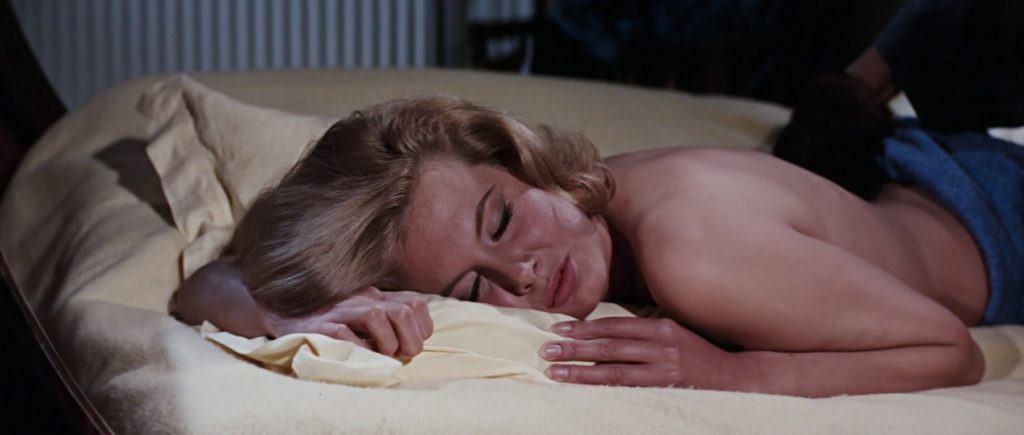
It’s interesting to note Bond’s relationship with women in Thunderball (other than the fact that he aggressively hits on nurses and even blackmails one into sex!). For instance, all three save his life at one point in the film: Fearing saves him from a spinal traction machine set to full blast (since when do traction machines have kill switches?); Volpe coincidentally (ugh) saves him while he’s on the run from Largo’s goons before she herself betrays him; and Domino saves him from certain death by harpooning Largo at the film’s climax – a rare instance when the Bond girl is the ultimate victor. Already at this juncture in the series, the Bond girl “cliche” was being addressed with Volpe cheekily sneering, “Mr. Bond. James Bond, the one where he has to make love to a woman, and she starts to hear heavenly choirs singing,” a direct audience reference to Goldfinger‘s Pussy Galore.
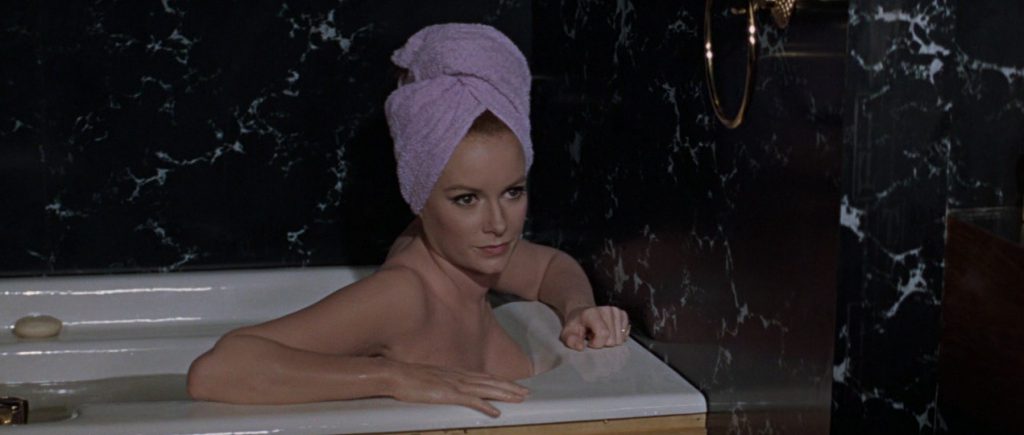
Thunderball saw the return of Dr. No/From Russia with Love director Terence Young for his final time in the series. While not as taut or well-paced as his previous endeavors, it does up the ante when it comes to violence and sex marking Thunderball as one of the most daring in the series – even when compared to today’s Bond films! The final underwater battle alone is a brutal combat through thick clouds of red blood and harpoons penetrating almost every conceivable appendage available – even, at one point, through an enemy’s eye! It’s a testament to the final years of American censorship that it was even released as it was!

Under Young’s direction, Sean Connery delivers what is perhaps his last classic performance as James Bond. By his next outing, it was evident that Connery had grown bored in the role and his subsequent return to the series thereafter was much more comical in tone. Here, Connery is still as stylish, charming, and brutish as ever albeit with a cheekier glint in his eye. Despite a growing reliance on gadgets, he does have a few brilliant moments of cleverness such as a scene when he tricks the villains into shooting at each other clearing his path for an escape.

The most heart-pounding episode in the film is a nighttime sequence where Bond is shot (an extreme rarity in the series) and chased through a Junkanoo street parade. Despite ducking in and out of parade floats, his bleeding injury leaves a trail for Volpe and her thugs to pursue him – an easy feat considering that Bond’s blood is practically a bright red neon roadmap! Seriously, whose blood glows that brightly in the dark? Is it indicative of a secret chemical compound that produces the immortality he has enjoyed for over 50 years? Either way, the chase climaxes in an outdoor nightclub where Bond, now surrounded by the villains, is forced into a doomed dance with Volpe with a gun pointed at him ready to go off in time with the bongo beat! It’s like a mini-version of the concert in Alfred Hitchcock’s The Man Who Knew Too Much only with a much more macabre ending!
Less effective are many of the hand-to-hand brawls in the film which feature an overuse of fast-motion editing. This is most evident in the final battle with Largo onboard his out-of-control ship, the Disco Volante, which reaches Benny Hill levels of sped-up hilarity! If the sound effects matched the speed displayed during the fight and bad back projection, it’d sound like something akin to a homicidal episode of Alvin and the Chipmunks. Considering the Oscar-caliber achievements on display throughout Thunderball, it is unfortunate that its ending showcases so poorly.
Of course, it wouldn’t be a 007 on the 7th review without mentioning Bond’s trusted American manservant Felix Leiter. Here, played by Rik Van Nutter, he is far younger than his previous appearance yet the extra wrinkles are not all that he lost between films. Any hint of charm or capability is thrown out the window. Nutter’s performance makes Keanu Reeves at his worst look like Anthony Hopkins by comparison. It’s no surprise that before he can utter a single sentence, Bond punches him in the stomach. Bond’s excuse? Leiter was about to give him away as 007 in front of Largo’s henchman – an excuse he happens to give Leiter in front of said henchman! My theory: Bond was just sick that Leiter returned to wearing those ridiculous sunglasses of his!
Ian Fleming (and Company)’s Thunderball |
Thunderball, for the most part, is very faithful to Ian Fleming‘s original novel which is not a big surprise when considering that the original draft was actually a screenplay co-written with Kevin McClory and Jack Whittingham before Fleming’s consequent deal with EON, the production company behind all the official Bond films. When the film project fell through, Fleming took the draft and released it as the ninth entry in the 007 book series which led to a much publicized plagiarism case from McClory and Whittingham. The result of the case would bring about decades of legal trouble for the Bond team, as McClory (who received a producer credit in the finished film) argued that he owned the rights to S.P.E.C.T.R.E. (which made its debut in the novel), Bond’s archnemesis Blofeld, and more. Eventually, the Bond series would drop S.P.E.C.T.R.E. and further court cases gave McClory the right to produce a rival Bond film – Never Say Never Again, a Thunderball remake, also starring Sean Connery! In recent years, as evidenced by the title of the most recent Bond film SPECTRE, EON finally retained the rights lost to McClory thus finally closing a gap to a half-century worth of legal battles!
Cross-Dressing Widows and Jetpacks |
Thunderball continues the precedent set by Goldfinger‘s pre-credits teaser with Bond in a deadly brawl against an evil agent – in this case, Colonel Jacques Bouvar, a S.P.E.C.T.R.E. assassin disguised as a widow at his own funeral! How does Bond decipher the con? Simple: he notices him opening his car door instead of allowing a gentleman to do so for him! Of course, no self-respecting high class widow would ever allow for such a condescending act! In the very next scene at Bouvar’s home, Bond approaches “her” to share his condolences and immediately decks him. I would love to witness an alternate version where Bond was mistaken! After a decent brawl that destroys almost every item in the room, Bond escapes Bouvar’s guards using a jetpack before finishing the job by spraying down the remaining thugs with a pair of water canons on his Aston Martin.
So let’s get this timeline straight:
- Bond discovers Bouvar’s con at the funeral.
- He is somehow able to beat him home even though he has a significant head start.
- He manages to sneak into the house past any guards already there.
- He has time to set up a jetpack on the roof for a possible escape.
- Finally, he plants himself in the very room that Bouvar just happens to enter in alone.
How in the hell was he able to pull that one off and solely on the basis of a car door error? Even stranger, just where could a small Aston Martin store so many gallons upon gallons of water to effectively shoot two long lasting canons?
On the plus side, the opening credit sequence once again makes great leaps for the series in what has become one of the most iconic (and frequently parodied) of all the Bond openings. Set to Tom Jones’ rendition of “Thunderball,” the sequence features nubile nude swimmers silhouetted against colorful backgrounds whilst avoiding the harpoons of scuba villains swimming nearby. It’s a neat idea that foreshadows the underwater setting of the film and is strong enough to obscure the obvious matte lines for some of the shots.
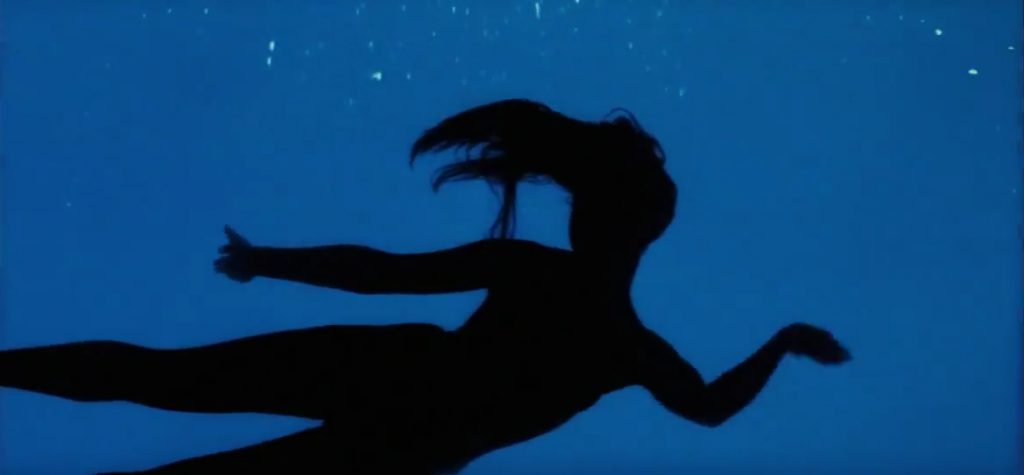
Tom Jones’ song is adequate, mostly famous for his last trumpeting note which, as legend has it, caused him to pass out while recording. More interesting is the original intended song, “Mr. Kiss Kiss, Bang Bang,” a catchy tune whose instrumental can be heard throughout the film, particularly during the nightclub sequence – a club “coincidentally” called the Kiss Kiss Club. Recorded by Goldfinger‘s Shirley Bassey and later Dionne Warwick, it is a superior tune that was unfortunately dropped in favor of a song that matched the film’s title. Another dismissed possibility was submitted by none other than Johnny Cash! While a definite curiosity, and possibly my favorite of the three, it sadly wouldn’t have worked well with the tone of the picture.
Final Thoughts |
Early in the film, S.P.E.C.T.R.E. states that their evil plan would be the most ambitious project they have ever undertaken. Unsurprisingly (spoiler alert?), they fail. In many ways, that perfectly describes Thunderball for the James Bond series to this point. In the endeavor to outdo the previous films with spectacle and action, the film lost sight of many of the basic constructs that made them so successful. While there is much to admire in Thunderball – its underwater effects alone, despite being lengthy, are an extravaganza – it regrettably gets bogged down by silly plot holes, plodding scenes, and ludicrous coincidences. For everything it gets right, it equally gets something wrong leaving a final product that remains nothing more than adequately buoyant.
Random Afterthoughts… |
Thunderball‘s widescreen format necessitated that the familiar opening gunbarrel be refilmed to fit finally giving Sean Connery the opportunity to star in it (his stuntman had appeared in all the previous films!). Is it just me or maybe they should have used a better take? Connery particularly looks a bit awkward with a blatant wobble as if he’s about to lose his balance!

Many have often cited the ridiculousness of the title Thunderball. Beyond the mission codename, it has seemingly nothing to do with the plot or its underwater setting. “Thunderball?” Why not “thunderbolt?” Ostensibly random, they might as well have named the film “Rumblemittens” for as much as it has any reference to what’s going on.
As a matter of fact, this assumption is wrong on all counts. A little research reveals “thunderball” as a military term citing the resulting mushroom cloud of an atomic bomb – the worst possible result if Bond fails in recovering the two stolen bombs in the film. On the plus side, “thunderball” sounds really cool.
Following a funny exchange when Bond happens upon Volpe taking a bath, she steps out wearing nothing more than a small towel but in a quick shot, it is revealed in a mirror that she was wearing panties all along! Definitely a production goof, but it begs the question: just who wears panties while taking a bath? No wonder Bond was ambivalent about Volpe’s intentions!

What do the Jedi of Star Wars and James Bond have in common? Well, one of Bond’s handiest gadgets is the small rebreather device that allows him an extra few minutes of air in case of emergency. It proved so popular that it not only popped up again in On Her Majesty’s Secret Service and Die Another Day but also made an appearance in a galaxy far, far away in the Star Wars prequels. Apparently Q is doing quite well for himself servicing clients across time and space.

If you were to take a shot every time Domino changes into a different bathing suit, Thunderball would have a good chance of being much more enjoyable in my opinion. It’s as if Claudine Auger had a contract that she would get to keep any swimsuit featured in the film and asked the costumer to go crazy. My evidence? In one scene where Bond visits Largo’s house, she catches notice of Bond and Largo staring at her after emerging from a pool. Shyly, she says that she’s going to get changed. And what, pray-tell, does she get changed into? A skimpier swimsuit, of course!


At the very end of the film, Largo’s nuclear physicist betrays him to valiantly save Domino from torture – a rare twist for such a minor character. As the Disco Volante loses control and is on the verge of crashing, Bond, Domino, and the physicist are left with no other option than to jump. The physicist pleads with Bond telling him that he doesn’t know how to swim but he is quickly rejected, handed a lifesaver, and told that it’s never late to learn. After all three jump and the Volante explodes, the poor, heroic physicist is never seen, mentioned, or heard from again! Even worse, Bond uses a skyhook to fly him and Domino to land conceivably leaving the poor guy to cling to a small lifesaver in the middle of shark infested waters! How’s that for gratitude?!

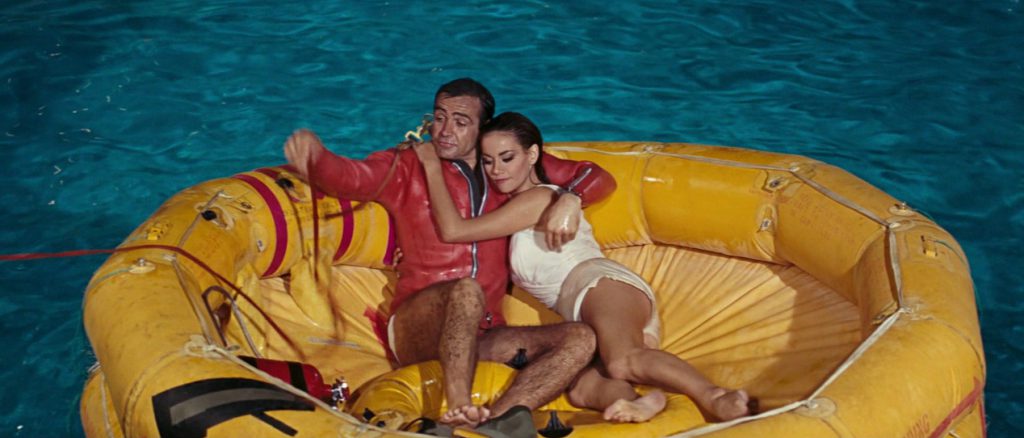
James Bond will Return
in
Casino Royale (1967)
Join 007 on the 7th of next month! For more, click here.












